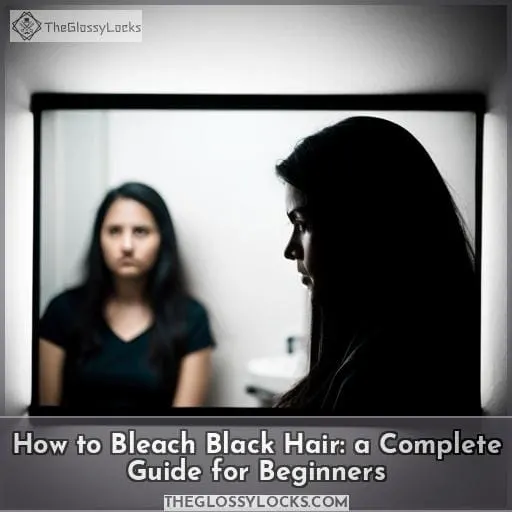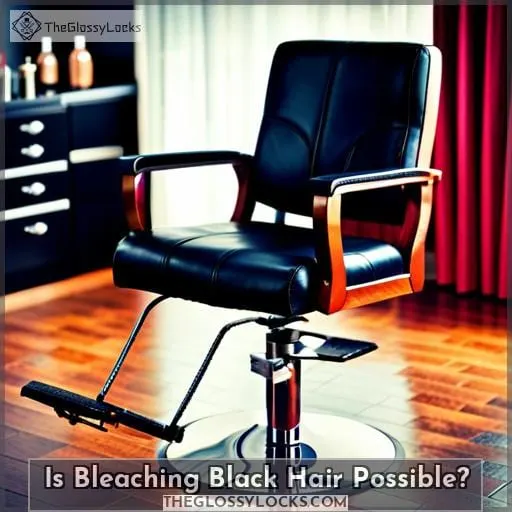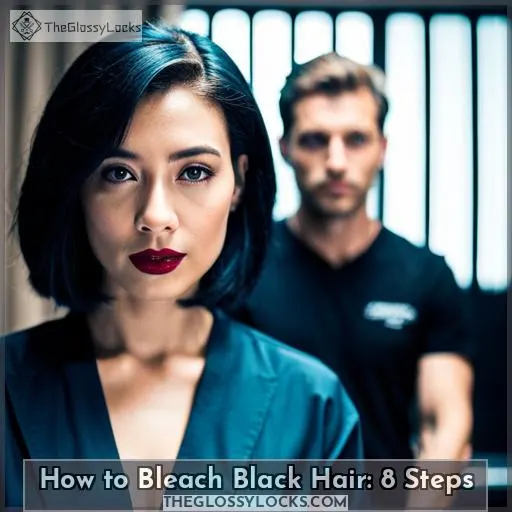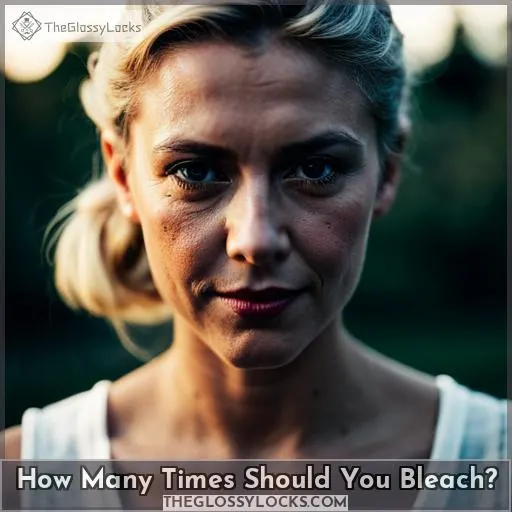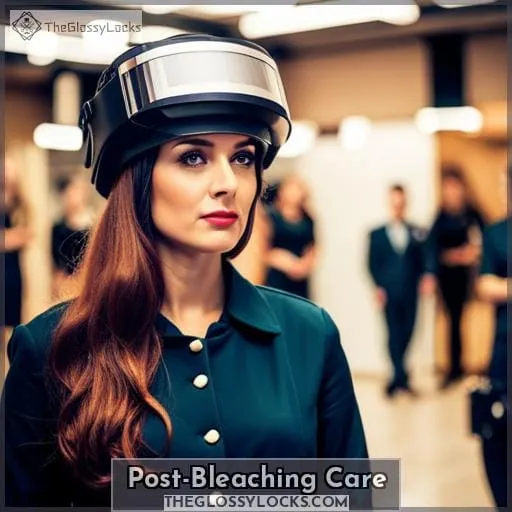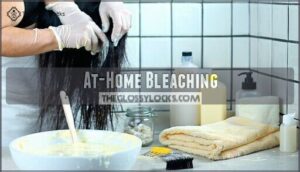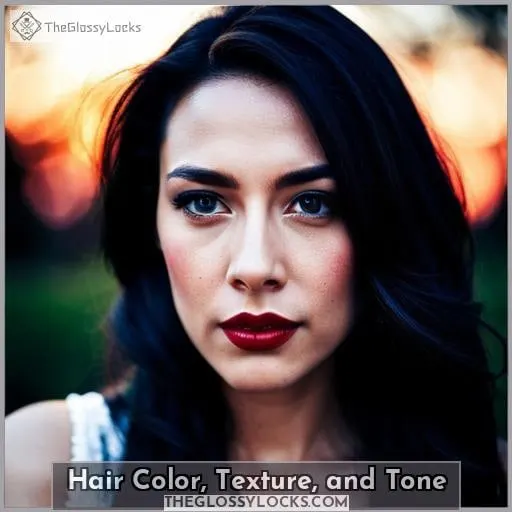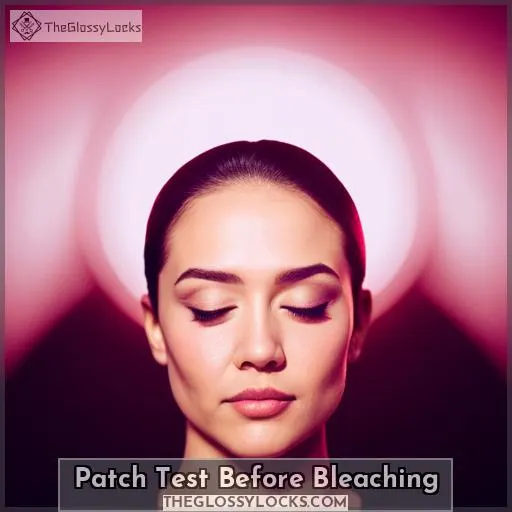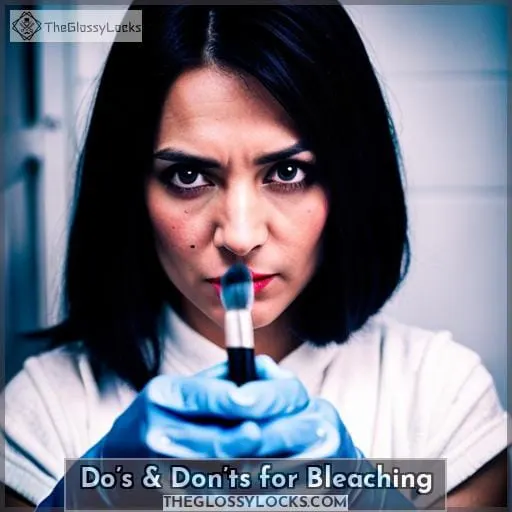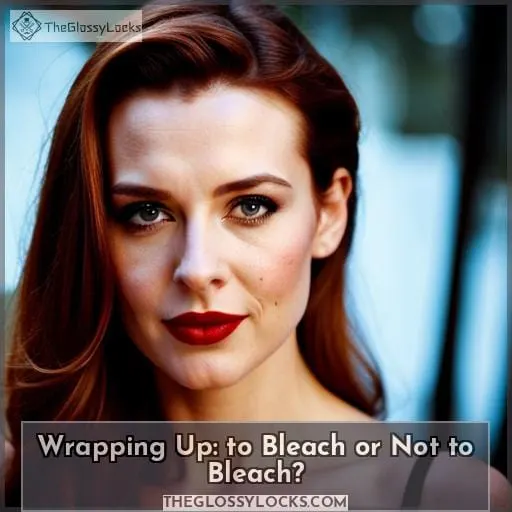This site is supported by our readers. We may earn a commission, at no cost to you, if you purchase through links.
 Surprising as it may be, you can bleach black hair at home! But how exactly do you go about doing that safely? If this is your first time attempting to lighten dark locks, then this article is tailor-made for you.
Surprising as it may be, you can bleach black hair at home! But how exactly do you go about doing that safely? If this is your first time attempting to lighten dark locks, then this article is tailor-made for you.
Here we’ll discuss the tools needed and steps involved in bleaching dark hair and answer a common question: how long does it take to bleach black hair? We’ll also provide tips on toning the hair afterward and some helpful dos and don’ts.
Table Of Contents
- Key Takeaways
- Is Bleaching Black Hair Possible?
- How to Bleach Black Hair: 8 Steps
- How Long Does It Take to Bleach Black Hair?
- How Many Times Should You Bleach?
- Post-Bleaching Care
- At-Home Bleaching
- Hair Color, Texture, and Tone
- Patch Test Before Bleaching
- Do’s & Don’ts for Bleaching
- Wrapping Up: to Bleach or Not to Bleach?
- Frequently Asked Questions (FAQs)
- Conclusion
Key Takeaways
- Bleaching black hair requires multiple rounds of bleach and proper preparation.
- Bleach should not be left on for more than 30 minutes to avoid irreversible harm.
- Toning the hair afterward helps eliminate brassiness and orange hues.
- Regular use of deep conditioning treatments prevents dryness and brittleness caused by bleaching.
Is Bleaching Black Hair Possible?
You can transform your hair from dark to light, but it won’t be easy—so take the time to understand how bleaching works and properly prepare for it! Bleaching black hair requires multiple rounds of bleach, which is why understanding the risks involved is key.
The quality of your existing hair will determine how frequently you should check in with a professional. If you are attempting an at-home job, then remember that patch tests are essential—especially when using hydrogen peroxide or bleach powder.
Prior to bleaching, coconut oil may protect against damage. However, leaving bleach on beyond 30 minutes can cause irreversible harm. Therefore, do not let any product linger more than 60 minutes before rinsing off thoroughly with cool water.
Afterwards comes toning—a handy tip that helps eliminate brassiness and orange hues. Additionally, extra care is needed to combat dryness caused by this process. So, use nourishing treatments regularly until the desired hue has been achieved.
Some people find their virgin locks easier to work with, but no matter what type of darkness needs lifting, knowledge must come first! Read instructions carefully beforehand, blend products correctly without harsh lines, and always double-check allergies or sensitivities during strand testing times.
These tips will have liberation seekers feeling empowered over their choice while remaining informed about potential consequences along the way.
So don’t rush into changing up those luscious locks just yet—plan ahead instead for a successful transformation.
How to Bleach Black Hair: 8 Steps
Ready to take the plunge and bleach your black hair? Bleaching is a multi-step process, so it’s important to be prepared before diving in.
To get started, apply coconut oil or olive oil as a protective layer for your locks. Then, assemble all of the required ingredients—bleach powder, hydrogen peroxide, gloves, and more—before dividing up your hair into four sections.
Once everything is ready, mix up the bleaching powder with water according to package instructions. Then, begin applying it directly onto each section of hair from root to tip using an applicator bottle or brush.
With these steps taken care of, you’ll soon have perfectly lightened locks!
Step 1: Apply Coconut Oil/Olive Oil
Before bleaching, coat your strands with coconut or olive oil to protect them from damage. Applying oil has several benefits: it helps prevent breakage caused by the chemical reaction of bleach and hair dye, while also providing a protective barrier against potential allergies.
When blending products together for bleaching black hair, always do a strand test first to check for any adverse reactions. After applying the mixture, use protective measures such as gloves and goggles if necessary.
Take time to understand how lightener works before using permanent hair dye. It’s essential in order to achieve desired results without damaging your locks.
Step 2: Assemble the Required Ingredients
Gather the necessary supplies, such as bleach powder and hydrogen peroxide, to begin bleaching your black hair. Protect yourself with protective measures like a shower cap and plastic gloves when prepping tools for use.
Do a patch test beforehand to ensure no adverse reactions occur during the bleaching process.
Follow tips on mixing the right volume of bleach developer with dye for the best results – too much can cause damage! Keep an eye on timing; leaving it in longer than 30 minutes can be damaging, so make sure you keep track of time carefully throughout this process.
With these helpful bleaching tips plus understanding how lightener works, you’ll have a beautiful color transformation without risking any harm!
Step 3: Divide Your Hair Into Four Sections
Divide your locks into four manageable sections to get started on bleaching your hair. Utilize a sectioning technique and apply the bleach consistency of choice with protective wear.
Strand testing is essential for best results, as well as following timing guidelines and using specific products – all depending on desired color! Start at the tips of your hair first when doing one-step lightening then move up towards roots; this will allow more time for processing in areas that need it most while protecting cuticles from being over processed too quickly.
Follow these tips to achieve great results without damaging strands!
Step 4: Mix the Bleaching Powder
Mixing the bleaching powder correctly is essential for achieving the desired results. Take your time and make sure it’s blended well – 10 minutes should do the trick. Don’t leave the bleach on for more than 60 minutes or you could damage your hair! Use a patch test, wear gloves, and use the proper proportions from a hair bleach kit with a plastic bag and bowl to avoid harsh lines.
Step 5: Apply the Bleach
Apply the bleach quickly and evenly, but don’t leave it on for more than 30 minutes! Use a patch test, gloves, and use the right proportions from a bleaching kit with a plastic bag and bowl.
Monitor the light-yellow stage of the process using the virtual try-on feature. This will help avoid overbleaching. Apply the technique correctly to protect the scalp. Follow timing rules when using products from a hair salon or at home.
Seasoned bleachers utilize test strips as an indicator instead of aggressive chemical processes alone. Body heat helps develop color faster during the bleaching process. Keep these tips in mind to ensure your hair is protected throughout the entire procedure.
How Long Does It Take to Bleach Black Hair?
Knowing your hair color, texture, and tone is half the battle – so take time to prepare before diving into bleaching black hair.
Preparing for this process includes doing a strand test and patch test to check for any allergies, as well as applying coconut oil or olive oil beforehand. Once you’re all prepped up, it’s time to mix the bleach powder with water according to package instructions in order to start the actual bleaching process.
How long does it take? The amount of time needed depends on the existing color and texture. However, leaving bleach on for more than 30 minutes can cause damage, while leaving it longer than 60 minutes will result in severe damage such as hair loss or super-blonde hair without desired results.
At-home bleaching requires specific tools like gloves, a bowl, etc., but consulting a professional first is advised given its risks linked with hair damage due to its harsh nature when done incorrectly at home!
Finally, post-bleaching care involves toning your locks afterwards, which helps eliminate brassiness and orange hues from appearing, plus nourishing them afterward so they don’t become dry or brittle throughout this journey towards changing their current look!
With proper knowledge about what you are going through, along with taking extra precautionary measures by reading instructions carefully before each step of bleaching black hair, there won’t be anything that could prevent you from achieving exactly what was planned initially!
How Many Times Should You Bleach?
When it comes to bleaching black hair, the amount of times you should do it depends on your particular hair type and quality – so make sure to allow for some recovery time between sessions.
Doing a patch test and strand test before each bleaching session is essential. This will help determine if there are any allergies or sensitivities that may be triggered by the bleach.
When mixing the bleach powder with water, take extra care in blending them properly as this will ensure an even application without harsh lines being left behind afterwards.
Bleaching duration should not exceed 30 minutes at any given time since leaving it on too long can cause severe damage such as hair loss or super blonde hues instead of getting that desired gorgeous blonde look!
If done correctly at home, this process could save you money but requires specific tools like gloves, bowls, etc.
Different shades require different amounts of bleaching time; lighter shades need less while darker ones demand more attention when trying out various techniques which can lead up to perfecting that right shade for yourself within no considerable amount of time and effort compared when going somewhere else!
Post-Bleaching Care
After bleaching your hair, it is essential to take care of it. Toning the hair post-bleaching helps eliminate brassiness and orange hues that can occur. Additionally, nourishing the hair with proper conditioning treatments is important to combat dryness and brittleness caused by bleaching agents.
Toning the Hair
After bleaching your hair, toning can help eliminate any brassiness or orange hues and give you the look you desire! Toning is important to achieve optimal results.
There are several types of toners available in the market for different hair tones and textures. It’s also essential to protect your hair against damage caused by bleach powder when blending them properly during patch testing or allergic reactions.
Natural light can be used as a great resource alongside using a fully inclusive bleaching kit, which includes gloves, bowls, etc.
It’s also important to remember that regular use of deep conditioning treatments will ensure healthy-looking locks, even if they were previously damaged from overbleaching!
A common misconception about post-bleaching care is that it does not need attention, but this could not be further from the truth.
By following these steps, you will have gorgeous blonde tresses without much trouble!
Nourishing the Hair
Nourishing your locks regularly after bleaching is essential to keep them healthy and vibrant, just like a garden needs tender care for its flowers to bloom.
Regular use of deep conditioning treatments will drench the hair in moisture and prevent color fading, as well as split ends.
Heat protection products can also be used when styling with heated tools such as curling irons or straighteners, which help preserve the hue and luster of your tresses!
Garnier Nutrisse D has an array of nourishing masks that are perfect for this purpose. They provide invaluable tips on how long each mask should be left in depending on individual hair type – from 10 minutes for those with sturdy strands up to 30 minutes treatment time if you have fragile hair.
By following these steps, you’ll ensure beautiful blonde locks without hassle!
At-Home Bleaching
If you are considering bleaching your hair at home, there are a few things to consider. Firstly, having the right tools and safety precautions is key to achieving desired results. You will need gloves, a bowl or container suitable for mixing bleach powder with hydrogen peroxide, as well as other items such as an old towel and clips to section off the hair.
Secondly, it is important to read instructions carefully before attempting any type of dyeing process, including bleaching black hair at home.
Required Tools
Preparing for a successful at-home bleaching session requires specific tools like gloves, a bowl, bleach powder, and more – don’t forget these items! Ensure your DIY tools are up to the task and use protective oils like coconut oil on your hair before you begin.
Strand tests should be done prior to using any type of bleach or colorants as this will help you understand how well it works with your hair texture. Depending on what color blonde hue is desired, different types of bleach can be used, such as hydrogen peroxide or cream developer for short hair.
If opting for a home dye kit instead of purchasing individual components separately, make sure all the pieces come in one box, including some transparent plastic bags which are necessary when lightening dark strands.
Remember that safety comes first by following instructions carefully when working with chemicals to ensure the best results without damage!
Safety Precautions
Before you start your at-home bleaching adventure, make sure to take the necessary safety precautions to avoid potential damage.
Protective gear like gloves and glasses should be used when handling harsh chemicals.
Patch tests are also an important step before bleaching as they help determine hair quality and how long it will take for desired results.
Allowing enough time between each bleach session is crucial in order to prevent further hair damage from occurring.
Not following professional standards can lead to adverse effects such as dryness or brittleness, so taking extra care is essential throughout the process.
A common mistake made by many people attempting DIY bleaches is leaving bleach on too long – this can cause irreparable harm beyond repair!
Taking these precautionary measures will ensure that your at-home blonde transformation goes off without a hitch!
Hair Color, Texture, and Tone
Understanding your hair color, texture, and tone is essential for achieving the perfect bleaching results; it’s like painting a canvas with the right colors! Knowing what type of coloring you have – permanent or semi-permanent – will help determine how long it’ll take to bleach black hair.
Permanent is usually more difficult to remove than semi-permanent since its molecules are larger, so multiple rounds of bleaching may be necessary.
Hair quality also plays a role in determining time as thicker strands can handle higher levels of hydrogen peroxide and bleach powder without damage compared to finer textures that require shorter processing times.
It’s important not to leave bleach on for longer than 30 minutes at a time; otherwise, this could cause severe damage, which can result in weakened strands or breakage. That being said, leaving the product on for no more than 60 minutes should be sufficient enough for those with darker shades.
However, if you’re aiming for an even lighter hue, then additional rounds might be required depending on your desired outcome as well as the natural dark color underneath any existing dye job.
Before starting anything, make sure that patch testing has been done properly since allergies must always be checked first before going ahead with any kind of lightening process. Applying coconut oil beforehand helps protect from potential dryness, while using purple shampoo afterwards assists in toning out brassiness when dealing with orange hues post-bleaching session.
In order to keep up healthy-looking locks, following aftercare tips such as using deep conditioning treatments, avoiding heat styling tools, trimming away split ends regularly, etc.
Starting off from the bottom section near the neck area rather than top layers allows better control over application too; once roots have reached the desirable shade, gradually work through other parts until everything matches the desired level evenly throughout the head!
Patch Test Before Bleaching
It’s essential to always do a patch test before bleaching, as it could potentially save you from experiencing an allergic reaction or other damaging side effects. Checking for sensitivity should be done first before attempting any kind of lightening process.
The mixture used should not exceed more than 30 minutes at a time. This is especially important when dealing with black hair since multiple rounds may be required in order for the desired color to appear.
When doing your patch test, make sure that you are using both gloves and eye protection so no product gets into contact with the skin – this includes the scalp area as well! The results after one single session might not reflect what shade you’ll achieve once all parts have been bleached evenly.
Different tones can show up depending on where bleach was applied most heavily, which means blending properly is key here. When aiming for cool blonde hues, leave bleach on longer (but still within 60 minutes) so lighter strands come through without overprocessing darker sections near roots.
Doing additional tests along the way also helps determine how much developer strength needs adjusting accordingly based on reactions seen during each round.
Do’s & Don’ts for Bleaching
If you’re considering bleaching your hair, it’s important to be aware of the do’s and don’ts. Doing this properly is key for achieving a desirable outcome while minimizing potential damage to your locks.
When it comes to black hair in particular, the process can take multiple rounds, so knowledge on how long each session should last is vital.
- Make sure you use gloves and eye protection when testing sensitivity.
- Leave bleach on no longer than 60 minutes per round.
- Apply coconut oil before starting any lightening processes as a protective barrier.
- Blend evenly around the scalp area so darker areas near roots don’t get overprocessed with too much product or time!
And here are three must-avoid practices:
- Never leave the bleach mixture on for more than 30 minutes at once as this could cause irreparable harm.
- Avoid using hydrogen peroxide when possible due to its harsh nature that increases the risk of drying out strands even further beyond the already dehydrated state from lightening agents used during sessions.
- Steer clear from doing an allover application until very confident about results after strand tests have been completed first!
Top 4 Do’s
Doing your research and taking the proper precautions is essential for bleaching black hair. On average, it can take up to 6 hours with multiple rounds of processing. To achieve satisfactory results, coconut oil should be applied before bleaching as this helps protect the hair from damage.
Additionally, a strand test and patch test are useful do’s in order to determine how your particular tresses will react to lightening agents used during actual sessions.
After shampooing session, post-bleach care requires extra attention. Use charts like the ‘Levels & Tones’ guide when toning afterwards if aiming for a new blonde tone. This will help keep brassiness at bay while nourishing locks back into a healthy condition quickly.
Following these steps will ensure that you get the desired color safely!
Top 3 Don’ts
Avoid leaving bleach on your hair for more than 30 minutes as this can cause damage, and never leave it on longer than an hour to ensure your tresses remain healthy.
When bleaching black hair, you should always do a patch test first to prevent any potential allergic reactions and monitor the processing time closely.
It’s important to blend the lightening agents properly in order to achieve good results with minimal damage. Select quality products that are designed specifically for bleaching dark tones of hair.
One of the most common occurrences when going through this process is overprocessing, so be sure not to take too much off all at once! The only thing worse than having brassy orange hues left in your locks is no color at all after you’ve gone through several rounds!
As mentioned earlier, post-bleach care requires extra attention. Use charts like the ‘Levels & Tones’ guide when toning afterwards if aiming for a new blonde tone or even darker shade.
At the end of this article, you’ll have great knowledge about how long it takes to bleach black hair and hopefully, you’ll get that good look without risking any further damage by following these simple tips!
Wrapping Up: to Bleach or Not to Bleach?
Deciding whether to bleach your locks or not requires careful consideration, as the process can be damaging and time-consuming.
- Benefits – Bleaching gives you beautiful blonde locks that may have otherwise been impossible without professional help!
- Damage – Taking extra care of your hair post-bleaching is essential in order to avoid excessive dryness or breakage due to strong lightening agents used during sessions.
- At-home tips – If attempting at home, make sure all necessary tools are gathered beforehand, such as gloves, a bowl, bleach powder, etc. Also, read instructions carefully and do a patch test prior!
- Alternatives – If looking for something less permanent than bleaching, there are great alternatives such as Garnier’s virtual try-on tool, which lets you find out what different shades would look like on yourself virtually first before making any decisions about coloring services.
Overall, it’s important to weigh up the pros and cons when deciding if having lighter-colored tresses really is worth it in the end for everyone individually.
Frequently Asked Questions (FAQs)
What products should I use to bleach my hair?
You’ll need hydrogen peroxide, bleach powder, and coconut oil to achieve the desired results.
How often should I bleach my hair?
Discover how often you should bleach your hair to achieve the desired look while protecting it from damage. Take into consideration your hair type and texture, and plan for recovery time between bleaching sessions.
Is bleaching my hair bad for my scalp?
Bleaching your hair can be damaging to your scalp if not done correctly. Always use protective gloves and read the instructions carefully before bleaching, as it can burn or irritate the skin. Coconut oil may help protect against damage, but a strand test is important for checking allergies.
Allow time between sessions for recovery; too frequent bleaching can lead to dryness and brittleness in hair strands.
Are there any natural methods for bleaching my hair?
Yes, there are natural methods for bleaching your hair. Try using chamomile tea or lemon juice to lighten specific strands gradually and safely. Applying honey or cinnamon can also help brighten locks while protecting them from damage.
Is bleaching my hair at home safe?
Bleaching your hair at home can be safe if done with caution. Arm yourself with knowledge and follow instructions carefully, ensuring you blend the bleach properly to avoid harsh lines. Use coconut oil for protection and do a patch test beforehand – remember, too much bleaching can cause damage! Make sure to read up on all the techniques before taking this plunge into liberation.
Conclusion
Bleaching black hair can be a tricky process, but with the right preparation and care, you can get your desired hair color without causing too much damage. However, it’s important to understand your hair color, texture, and tone before bleaching and to do a patch test beforehand.
Be sure to take your time and follow each step carefully, as rushing the process can leave your hair dry, brittle, and discolored. With the right know-how and dedication, you can achieve the look you want without damaging your hair.

